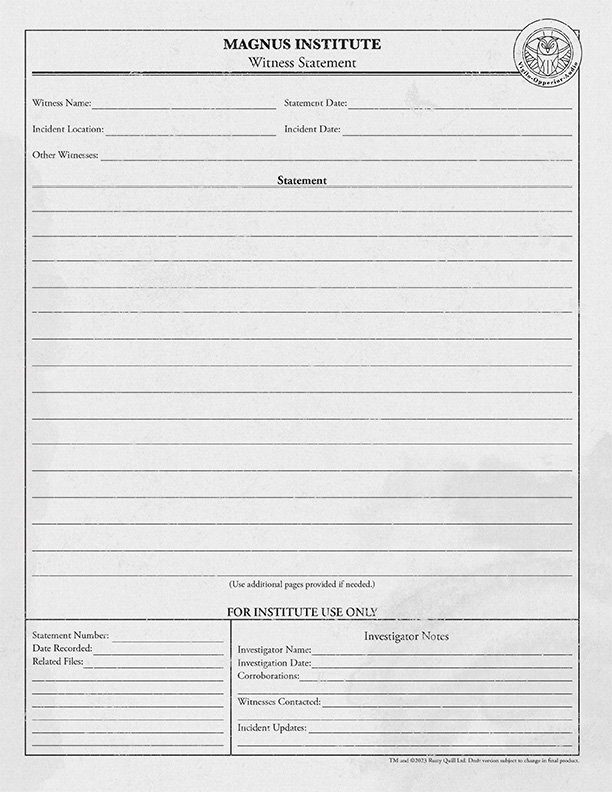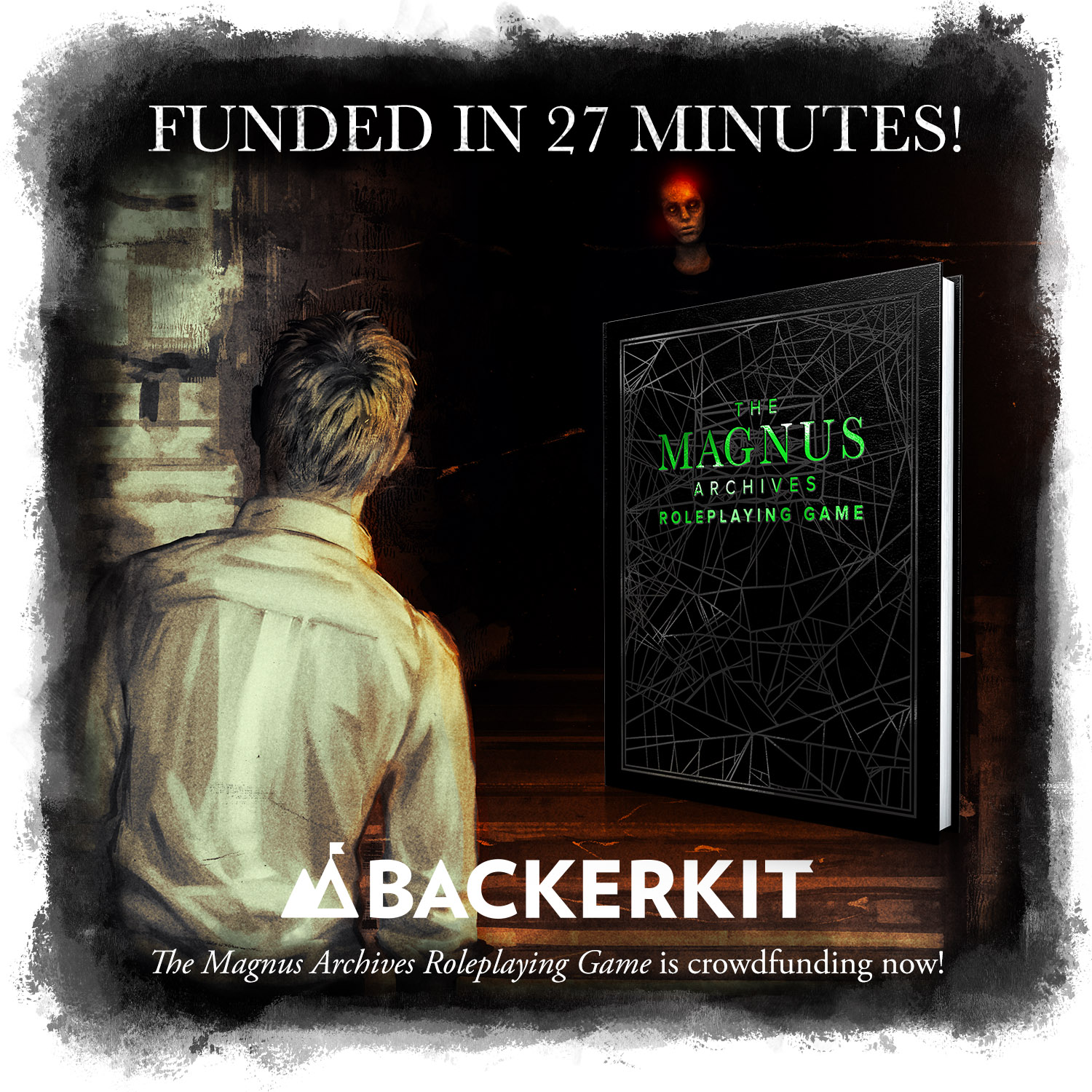One of the things that makes The Magnus Archives Roleplaying Game, currently crowdfunding and under development, so exciting for us are the new directions in which the game is taking the Cypher System. You can read about a few of the new mechanics in this article I posted last week.
Based on The Magnus Archives podcast—a popular horror fiction anthology by Rusty Quill—the player characters (PCs) play as investigators of the paranormal, as reported to them through witness statements. As integral as the statements are to the podcast, perhaps some would find it appropriate to have the group work together to create the statement. A roleplaying game is, after all, an exercise in group storytelling.
This article is a peek into the process of creating a statement as a group—it’s pulled directly from the current draft of the RPG. (You can learn more about The Magnus Archives Roleplaying Game on Backerkit—it’s crowdfunding now!)
Want to give it a try?
Download a copy of the Magnus Institute statement form—it’s a prototype of the form that will be included in the RPG. Have a look, or use the process described here to create a statement—the prolog and foundation of a The Magnus Archives Roleplaying Game adventure—right now!
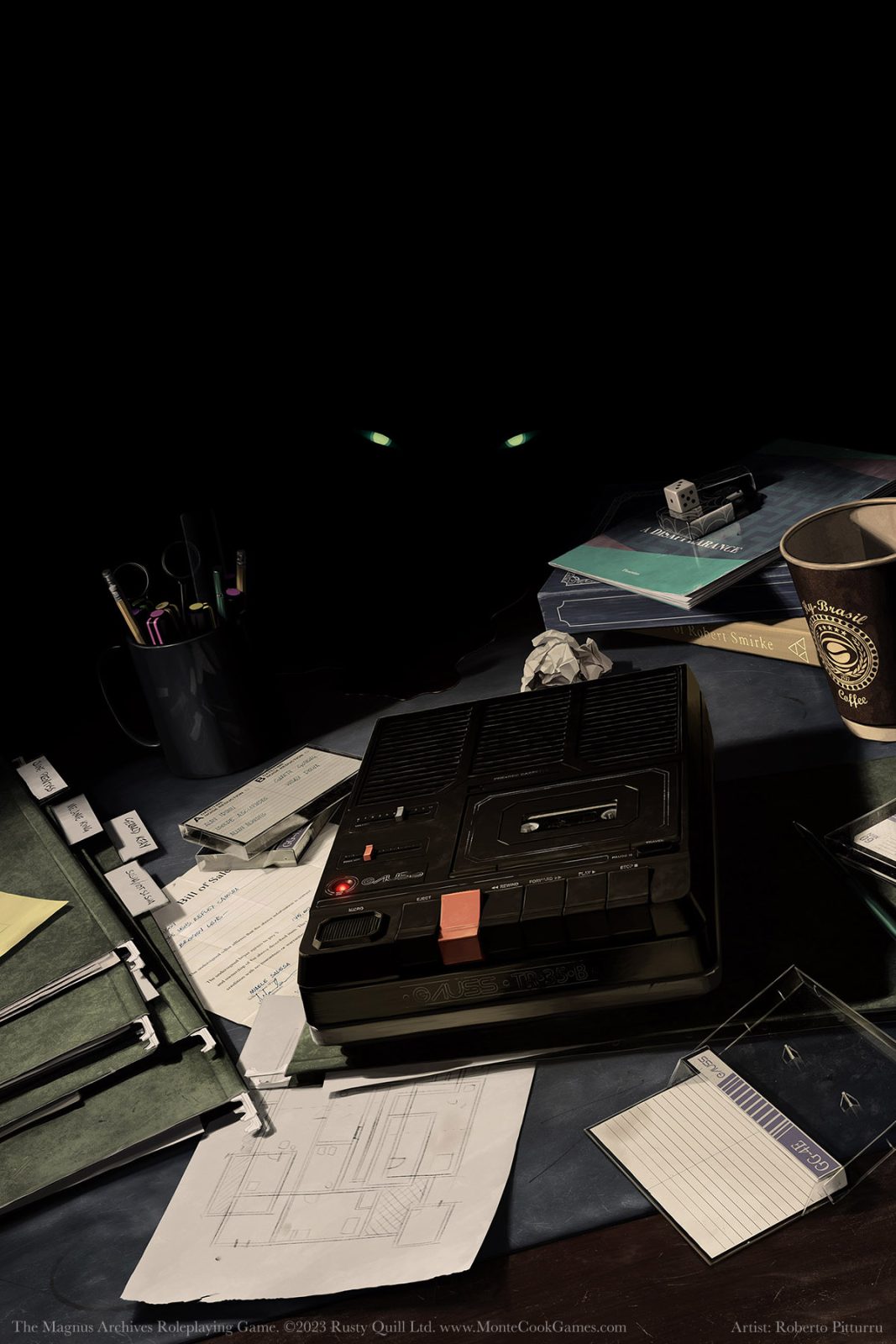
The Statement
If you’ve played a tabletop RPG before, you know that the GM gives the players a “hook” into the “adventure” so that they can become a part of the action (and in the case of The Magnus Archives, the horror). You can, of course, play The Magnus Archives RPG in this way.
However, The Magnus Archives podcast suggests a new opportunity as well. Just as nearly every episode begins with the recording of a written statement, in which someone relates the details of some potentially paranormal experience that they had, your own The Magnus Archives RPG stories can begin with a statement as well.
Now, again, this could be handled in the way of a conventional tabletop RPG, where the GM summarizes or reads aloud the text of a statement that begins the investigation for the PCs. The GM could even use the statement from an episode of the podcast, write up a statement and hand it out to the players, or perhaps go so far as to record the statement on their phone or other device.The Magnus Archives Roleplaying Game will have some suggestions and advice for GMs to do any or all of these.
The Statement Process
This is a group process in which everyone works together to create a statement, which will lead to an investigation for the PCs. The statement doesn’t involve the PCs—it’s something that happened to someone else, and the PCs use it as their primary bit of evidence to investigate the phenomenon it describes.
Remember that some statements might be accounts from far in the past, either given a long time ago, or found in the form of old letters or entries in journals. You could do this with your statement, but you would need to decide before you begin.
Statement By
One player takes the role of the statement author. (We use the term “author” because, in The Magnus Archives stories, they most often begin as written statements—even if they are later recorded as audio.) Very likely, in a campaign, there will be many statements, so everyone will get a turn in the statement author role. Perhaps multiple turns.
The player creates a name and a brief background for this author. Don’t worry about game stats or a character sentence. Just something like “Neal Philips, tax preparer at Mudder & Company.” Give them a bit of a personality that will come out in the first sentence or two of the statement. You could also start with something like, “I love my wife. Even after she tried to kill me, I still loved her.” That’s intriguing. Or “I’m not very good at my job. But really, it’s my boss’s fault.” This example only establishes a bit about the character. It’s okay if you don’t know where the statement (the story) is going. The next person will take it from there. These first few sentences should really focus on establishing the character. They can—but don’t have to—spark the story itself. Let’s use this opening sentence for our ongoing example moving forward.
Statement Begins
Building on whatever the author player said about the character, a different player takes the proverbial reins with a few sentences about the background of the story. This should incorporate the character as established, and it shouldn’t countermand or change what’s been said before. It also shouldn’t just tell the whole story, but provide a foundation for others to build upon. This can be in just the basic idea, such as, “Neal was told by his boss to meet with a weird lady who runs a chiropractic clinic where they’re doing weird stuff and Neal has to do her taxes.”
The purpose of the statement is to set the stage for the investigation the PCs will undertake. It raises questions—it doesn’t answer them.
This player (or any other player contributing to the statement hereafter) could add to what the prior player had said “in character” as well, continuing to use the first-person perspective. “The old man always gives me all the terrible clients. The weirdos. And so one day, about a year ago, I’m assigned to meet with a new client. She runs a chiropractic clinic, which is fine enough. I think they’re probably quacks, but that’s just me. She wants to meet at her office, so I travel across town and end up in her office. But there was something really weird…”
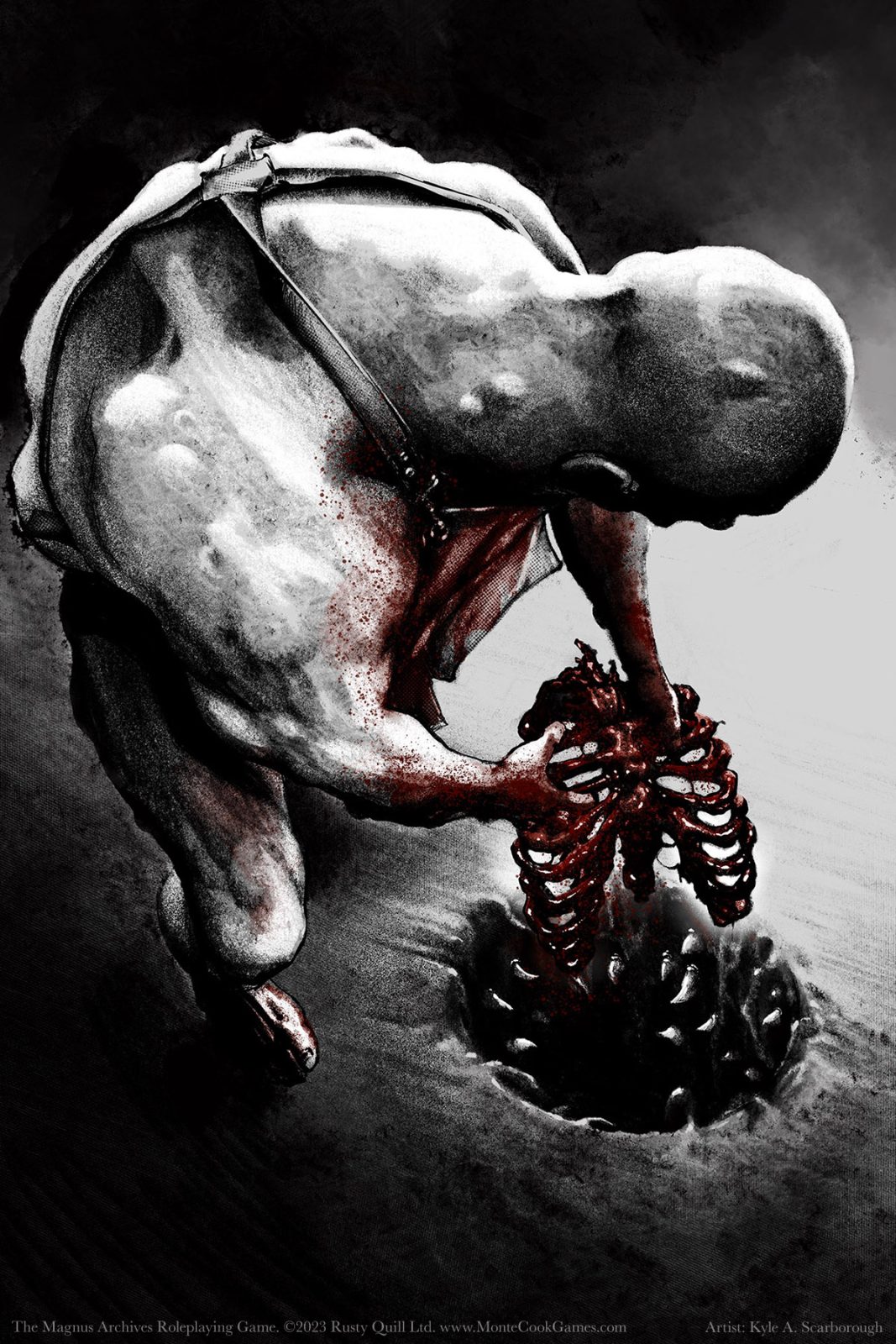
Fleshing Things Out
This is when a third player jumps in. They take what’s been said before them about the statement author and build upon it, fleshing it out with new details. Like before, this can just be the summary of an idea, like, “Her office is full of weird art—like diagrams of human anatomy but it’s all twisted and wrong.” Or it can be a continuation of the actual statement: “…about the art in her office. It was made up of diagrams of skeletons, bone structure, and that kind of thing. Which isn’t inappropriate for a clinic, except even I know enough about basic human anatomy to know that this stuff was all wrong. I mean, maybe it was all from the olden days, when they knew less, but I don’t think doctors of any kind ever thought some people have three arms.”
The GM Interjects
At this point, let’s give the GM the chance to pop in with a few thoughts, filling in blanks that will be important later on with additional details. For example, this tax client is clearly going to be a major NPC, so she needs a name, so they suggest one: Dr. Maria Tomlinson. The GM might give a few details about her appearance or manner. They’re the one that’s going to be portraying her, after all.
Unlike the other players, the GM can make minor changes to what’s come before. This is because the GM has to turn this statement into something the PCs can actually investigate, and might need some different details to work with. This should never change the essence of the statement, or erase something that one of the players really likes. For example, they might say, “In addition to the weird art, Maria’s office has taxidermied animals as decor, but they don’t look quite right. The limbs are bent, or the heads are too large.” In this example, the GM is thinking ahead and planning a possible encounter where these taxidermied beasts—and some even more twisted from the back room—animate and try to attack the PCs.
The GM doesn’t, most likely, actually add to the statement itself. They just insert or massage details for the players to use and build upon.
The Statement Author Reacts
Next, we return to the author. The player who created the author is sort of “playing” the character here, and so we need to know what they do or how they react.
In this case, it might just be something like, “I did my best to ignore the diagrams and the animals and got to business. After engaging with Dr. Tomlinson in a bit of small talk, I started asking her the standard tax preparer questions.” Alternatively the statement author might try to flee a scary scene or, due to their curiosity, slip in where they’re not supposed to go when no one is looking.
It’s not a bad idea to establish what the character is thinking about whatever they are experiencing, and this is an opportunity to further expand on the character’s personality if it’s interesting and relevant. “I just wanted to get the bare minimum of what I needed and get out of that place. I thought maybe I could stop at a bar on the way back to my own office for a drink. Or two.”
Obviously, this process creates a statement given by a normal person who probably started out not believing or knowing much about the paranormal. In the podcast, there are many statements provided by people involved in the deeper story, who might even be an avatar of one of the entities. In the game, those will appear rarely if at all.
The Awful Twist
Once the background has been set up and fleshed out, and we know what the statement author is doing and thinking, it’s time to get to the heart of the story. And because this is a horror story, the “heart” is usually expressed as a twist in expectation. The point isn’t to really surprise anyone (everyone involved knows this is a horror tale), but rather to show where things truly deviate from normal reality. This is the thing that makes turning to the Magnus Institute the only recourse the author has, because surely neither the police nor anyone else will believe their story.
In fact, this is the part of the statement where our narrator usually says something like, “I know you’re probably not going to believe this, but…”
This is when another player interjects with what we’ll call the awful idea. Something horrific and paranormal occurs. The statement author experiences something that should be impossible, and it’s terrifying to them. This moment could be rich in descriptive detail. For example, the player might state,
I know your institute deals in all manner of strange things—ghosts and strange whatever—but this isn’t some silly spook story. It was real. See, I was in her office getting the details I needed from her, filling out all the right forms and checking the right boxes on those forms, when… I don’t even know how to make sense of it. I mean, one minute I was asking for her expensed receipts and the next I’m on a table. I’m lying face down on a table. In a completely different room. Did she drug me? I might normally think that would explain a blackout, but it doesn’t explain what happened next. Dr. Tomlinson was standing over me with her hands on my back, as if she’s doing chiropractic whatever on me. Before I could say anything, though, her hands were moving across my back. Or rather, parts of my back were moving as she pushed on them. Parts of your back which aren’t supposed to move like that! I heard cracking and crunching noises that sounded like bones snapping. And if I really need to say it, it hurt like hell! The pain was sharp and forceful, like her hands were some kind of power tools. She was doing things to me that shouldn’t be possible.
(Of course, not every player is a poet, and there’s no reason it has to be this verbose. The player can simply interject the awful idea plainly if they’re not up for adding to the monologue. “Neal suddenly finds himself on the chiropractic table and she’s working on him, but it’s, like, making impossible changes to his body.”)
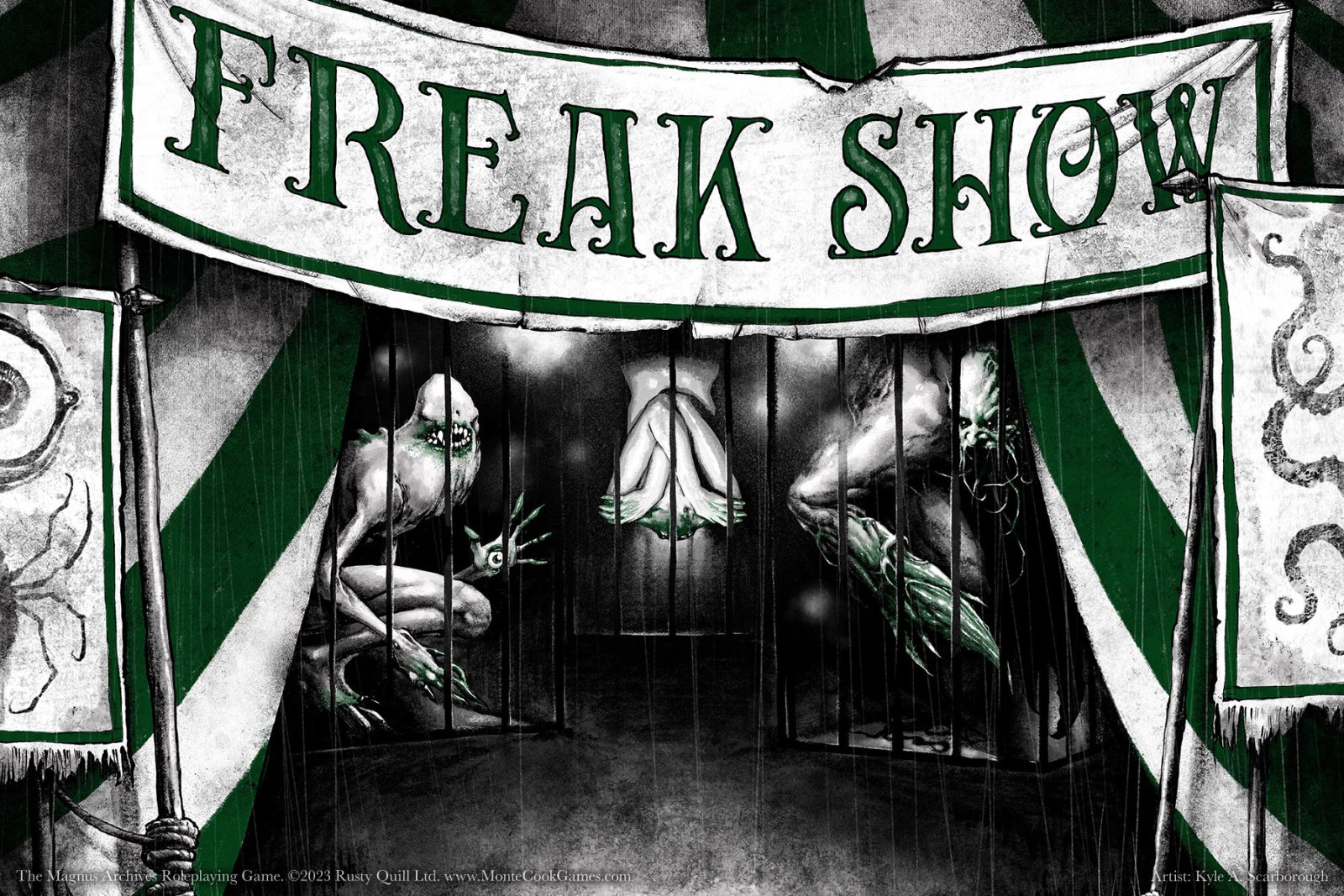
The Statement Author Gets Out
At this point, we go back to the statement author and let them decide how the character got from the horror to a position where they could give the statement. As before, this builds on what’s already been said—it doesn’t countermand anything. But the author player has complete agency to determine what happens, and what succeeds or fails. There’s no dice rolling in this process. The statement is a story from the past, and dice in the game are used to help determine the present and the future.
Your statements in the game won’t resolve the way statements sometimes do in the podcast. The statement author gets away (because how else could they give the statement?) but they never defeat the monster or villain, and they don’t solve any mysteries. The issue or problem that has arisen is in no way resolved.
Not every statement will involve the author running away. Sometimes, they’ll make a decision which allows them to avoid the impending danger, or they’ll just have an awful realization. Keep to the context to the story being told.
So our statement author comes up with something like, “Somehow, I managed to push myself off the table, rolling onto the floor with a thud. I scrambled to my feet, but still with snapping and crunching sounds coming from inside me. I was unable to fully straighten my back. The pain was bad, but my terror was worse. I scrambled to my feet and tore out of there.”
If you want, you can even throw in another, “I swear to you this truly happened. You have to believe me.”
Final GM Notes
The GM now has one last chance to insert some elements that can come back to be a part of the investigation. This is a great time to presage some little tidbits or set up some details that will become important later. It’s also a good time to insert info that will make the investigation work—if the statement has the main location burning to the ground at the end, for example, the GM can say, “But when they look back, the building still stands, as if there had never been a fire,” or something like that.
For example, in our ongoing statement here, the GM might add:
As Neal runs out, Dr. Tomlinson cries, “Come back, Mr. Philips, I’m not finished!” She sounds horribly disappointed, like an artist unable to finish her art.
Or perhaps:
As Neal flees, he catches a brief glimpse a hulking figure he hadn’t seen before coming out from a room behind the office.
Denouement
The denouement is how everything wraps up, and how the statement author gets to the point where they’re making the statement. At this stage everyone at the table can contribute. This is the last chance to make alterations to the statement and set up the investigation to come, so if there are needed facts or ideas too amazing to leave out, the players should propose them. The group as a whole must agree to incorporate them, but it behooves everyone to be open to all ideas and discard only those that truly don’t fit or contradict what’s already established. This isn’t the time to say, “oh, maybe instead of a tax preparer, Neal is an astronaut on a space station…”
To finish our example, the group might end up with this:
I went straight for my apartment, locked the door and passed out onto the floor. I woke up hours later. I felt better, and I could even straighten my back. But I just wasn’t feeling… right. Not pain, exactly, I just wasn’t comfortable in my own body. And my back was making weird crunching noises whenever I moved. I went to a close-by Urgent Care place—not that Mudder & Company has much of a health care coverage, but it’s all I had. Anyway, they sent me to the ER to get X-rays and the doctors there said one of my scapula was wildly out of place, and much smaller than it should be. They said that some of my vertebrae were missing, and were surprised that I could stand or move at all. But mostly, they said that I must have been born with these abnormalities. When I assured them that I hadn’t, they asked if I’d been in a serious car accident when I was a child. I told them no, but I don’t know if they believed any of this. They certainly didn’t seem to believe that a chiropractor could have done this to me.
I also went to the police, but they didn’t believe me. They said a bad chiropractor appointment wasn’t a crime. I went to a lawyer, but she said that based on what the ER doctors said, I didn’t have a case.
The denouement needs to end with the statement author coming to the institute to give their statement. It should explain why they didn’t go to more traditional authorities, or if they did, why that didn’t amount to much if anything.

Don’t worry too much if you don’t have the real-world knowledge to determine how the police would react, how things might realistically turn out at the end of the scary story. As long as everyone on the group is on board, it’s fine. And if someone has difficulty suspending their disbelief, it’s their responsibility to suggest a few changes or tweaks to the final story so that it all works in their mind. That is, in fact, one of the great things about having everyone contribute—not only is everyone invested, but everyone should find the story both believable and compelling.
Throughout this process, the players can take simple notes of the details. If desired, however, once the notes are made, you could actually have the statement author record a statement, just like it was from the podcast. (It might not be as long, or as eloquent, but that’s fine.)
Post Statement
The only thing that’s left is the bit that comes after the statement, as heard in the podcast. In most episodes, this is the Archivist talking about the context of the statement, or other relevant facts. In the game, it’s the GM creating the bridge that leads to the PCs’ investigation. Mostly, the GM simply adds a few things, if needed, that might be in the case file associated with the statement. For example, it might have Neal’s X-rays and medical report from the Urgent Care facility.
Sometimes, there might be information about what happened after the end of the statement, such as “Mr. Philips was reported missing three weeks after giving this statement,” but for the most part, that’s the kind of detail the PCs should learn when they go do their follow-up investigation, not now.
Here’s a way of thinking about what else might be needed—and what to leave to the investigation itself: If this was an episode of The Magnus Archives podcast, the actual adventure you play is basically what happens after the statement ends. The part in the podcast when the Archivist talks about the followup work and describes what the team encountered or discovered before the statement was recorded and (presumably) filed away—that’s your adventure.
The chapter on statements in The Magnus Archives Roleplaying Game will include short lists of “idea generators.” These lists of names, occupations, locations, and events can be used when the group needs some ideas. These will probably be mostly useful with the first few statements you create. After that, you’ll be surprised at how easy it becomes.
Final Thoughts
The statement process as delineated here is based very loosely on a storytelling game called sentence-at-a-time. It’s also got some roots in the Surrealistic art game called exquisite corpse. And of course, it’s tied very closely to the fundamentals of improv acting, with a heavy emphasis on “yes, and…” The purpose is to allow everyone in the group (who wishes it) to be a part of the process, while still having some order. As previously mentioned, the end result is hopefully one that everyone involved finds compelling, entertaining, believable, and—best of all—a bit scary.
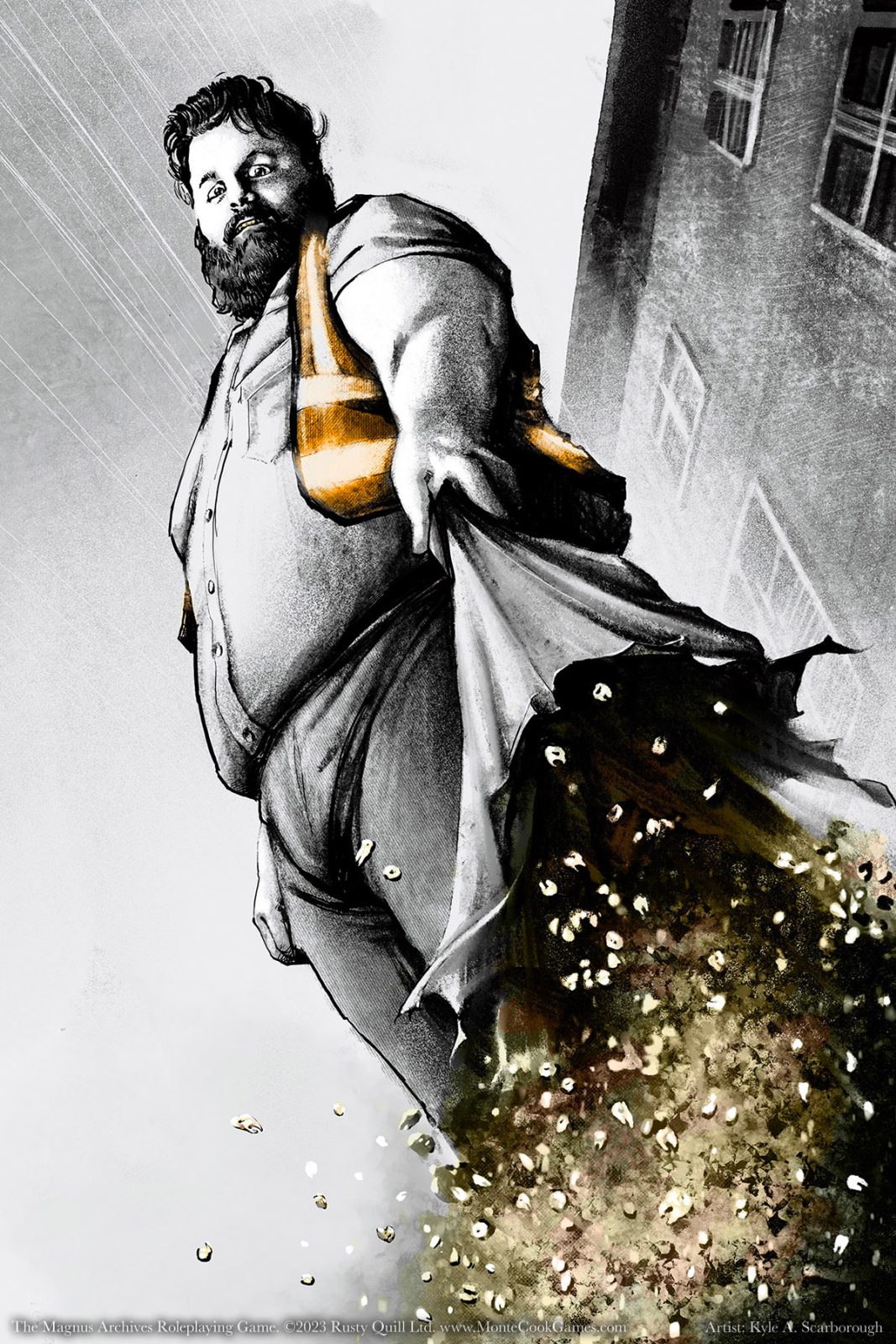
You can vary the statement process to avoid the statements becoming too formulaic. Perhaps there’s a different flow of events, with multiple encounters with the awful idea, or maybe there’s even an awful idea and a more awful idea. Perhaps the statement is actually a note hastily penned before the character died or disappeared. Maybe the statement is a follow-up on an investigation that the PCs conducted earlier in the campaign, and which they thought had been wrapped up or resolved. If these variations are to be used, the GM should probably be the impetus for doing so.
The chapter on statements in The Magnus Archives Roleplaying Game will be rounded out with extensive advice for GMs only, on how to take the group’s statement and turn it into an investigation, whether on the spot, or in advance of the session.
You’ll notice that in the examples, at no point does anyone say anything like, “Let’s make this one about The Flesh,” because that statement author presumably doesn’t know anything about the entities. Plus, starting with one of the entities often leads to disagreements about just what is and isn’t endemic to a particular entity, and puts perhaps unwanted limitations on the story. The point here is to create a harrowing, creepy, or disturbing story. Let the GM worry about how it fits into the larger setting.
Similarly, in the example no one tosses out information or ideas about things that the statement author couldn’t know, such as, “And the chiropractor secretly belongs to a cult, and they worship at an altar made of twisted corpses.” That might turn out to be the case, but the statement author doesn’t see or experience that (at least, in the time frame before making the statement). Try to keep the statement, and even discussions about the statement, limited only to the actual experiences of the statement author.
The Magnus Archives Roleplaying Game is a horror RPG based on the insanely popular fiction podcast. For 200 years, the Magnus Institute has quietly collected statements from people of all walks of life, detailing their personal experiences with the supernatural. These disparate statements can be unsettling—even deadly. And as one digs into the archives, the implications become truly terrifying, because these incidents aren’t as unconnected as they seem. But combatting the malicious forces that tie them together is dangerous, when even beginning to understand them might bring you under their influence.
The Magnus Archives Roleplaying Game is crowdfunding now!
